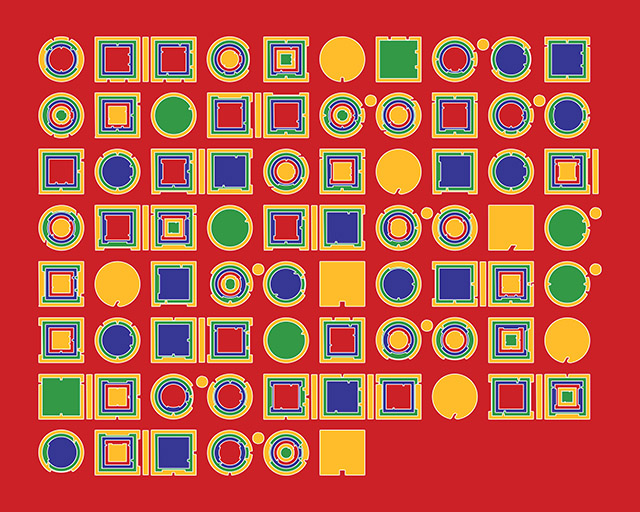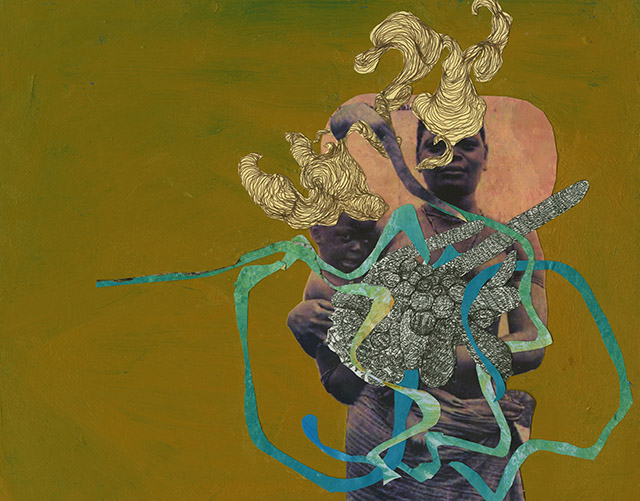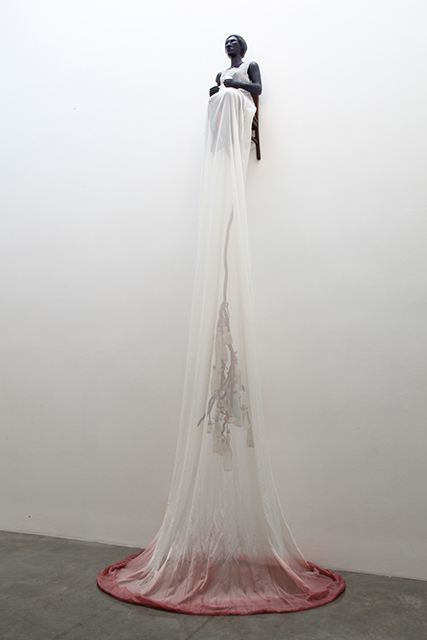After “re-imagining” their galleries, the Museum of the African Diaspora (MoAD) reopened yesterday with three solo exhibitions, featuring artists Tim Roseborough, Kenyatta A.C. Hinkle and Alison Saar. On a material basis, the trio’s work couldn’t be more different — from digital prints to rough-hewn figurative sculpture — but connective themes between the shows enrich each in turn, bridging generations, conceptual approaches and subject matter.

On the second floor, Roseborough’s small installation is the first of two “Emerging Artists” exhibitions selected by MoAD from a pool of nearly 50 applications. Proposals from local artists addressed the institution’s thematic lodestars: origins, movement, adaptation and transformation (helpfully arranged in large vinyl letters near the lobby ceiling). Roseborough’s exhibition Four Themes translates all four — literally — into a glyph-like alphabet of his own making.
Englyph (“English” plus “hieroglyphics”) nestles square and circular shapes of vibrant primary colors within one another, rendering the words “Life began in Africa” in a symbology that looks like a cross between Maya and sci-fi lettering systems.
Roseborough’s crisp digital prints accompany a video also titled Four Themes, which animates and gives a robotic voice to Englyph, each “word” bouncing like an indecipherable sing-along song when spoken. The banal, institutional language of MoAD’s mission statement becomes otherworldly and strangely mesmerizing, a great segue into the adjoining gallery’s display of Who Among Us…, Hinkle’s exhibition of drawings, collage, “artifacts” and video work.

One third of Hinkle’s exhibition is devoted to The Kentifrica Project, an ongoing ethnographic exploration of the “contested geography/continent” of Kentifrica (“Kentucky” plus “West Africa”). Previous iterations of the project have included serving Kentifrican food, inventing (like Roseborough) a Kentifrican alphabet and telling Kentifrican myths.
At MoAD, the objects on display include a piece of hemp rope with a noose at each end, the traditional attire of Kentifrican healers, a brightly-painted musical instrument and a map made from the hair of both the dead and the living. While these artifacts raise questions about those who would use them, Hinkle chooses to let the viewer imagine who those people are, without supplying representations of the Kentifricans.
Elsewhere, she doesn’t shy away from picturing bodies, namely female bodies. For Hinkle, the female body — like Kentifrica — is a contested site. French colonial photographs of West African women form the basis of The Uninvited, a series hung salon-style on one wall of the gallery. Collaged elements, glitter and paint cover the ethnographic images with malignant-like growths, referencing the diseases colonists brought along with their photographic equipment. And yet Hinkle’s work points to a reclamation of these images; her treatment is also decorative, a language of adornment in brushstrokes and patterns.

Upstairs, in Saar’s exhibition Bearing, the female body is stripped nude and emptied. Again and again, body parts (heads, breasts, hearts, bellies and lungs) become vessels. In Bramblin’ Blues, a hollow glass head lies inert to one side, filled with actual brambles. In Mammy Machine, a pump-activated contraption leaks water out of dangling, disembodied rubber breasts.
In sculptures and prints, Saar combines images and materials heavy with symbolism: cotton, tar, boxing gloves and — like Hinkle — hair. Her emphasis on both the external and internal, and the material differences between the two, illustrate racial discrimination, gender stereotypes and identity formation through steady repetition. Experiments with material and scale — a modestly sized woodcut print echoes a 16-foot-tall sculpture — demonstrate Saar’s iterative practice. There’s a lot to see, maybe too much, but that may just be a symptom of the third floor’s lower ceiling.
Four Themes is on view through Jan. 18, 2016. Who Among Us… and Bearing are on view through April 3, 2016. Visit moadsf.org for more information.